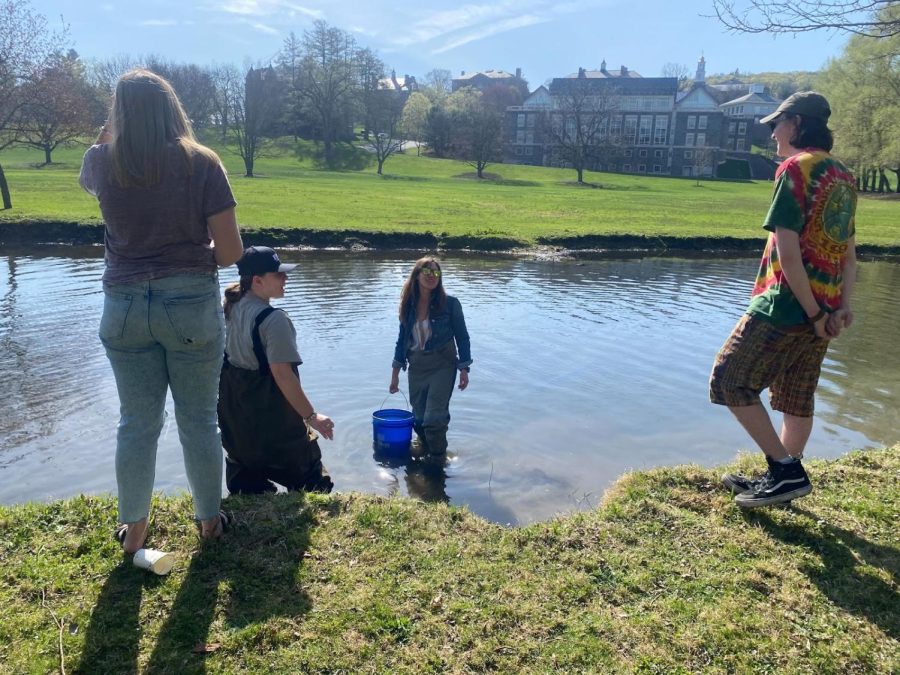Colgate Graduate Students Grow and Release Trout as Part of Teaching Program
Colgate University graduate students in the Master of Arts in Teaching (MAT) program released brook trout into the river alongside Willow Path as the culmination of a special teaching course on Friday, April 21.
The course, titled “Seminar on Curriculum and Instruction for Math and Science,” exposed student teachers in the Childhood Education division of the MAT degree to the mechanics of designing and implementing innovative science curricula for young learners.
Professor Meg Gardner, director of the Teacher Education Program and senior lecturer in Educational Studies, introduced the trout program to this course at Colgate. She organized her efforts as part of the nationwide Trout in the Classroom (TIC) program, partnering with the non-profit conservation organization Trout Unlimited. Relating to her research interests in integrated STEM education and teaching environmental justice, Gardner believes that the trout program has a lot to offer prospective teachers.
“The Trout in the Classroom program provides many teachable moments that connect students with their local natural surroundings,” Gardner said, “The program offers hands-on explorations in developmental biology, for instance, because of visible transformations from egg to fingerling-size fish. The tank also requires collective care, including daily feeding, water quality monitoring, and frequent water changes, that assist in classroom community-building.”
MAT students at Colgate initially harvested trout eggs in the fall, which hatched in Nov. of 2022. The young fish were cared for in a 60-gallon tank in the Educational Studies lounge in Persson Hall for months until they were mature enough to be released into Taylor Lake on Friday. MAT student Sophie Shaffer found this hands-on observational process to be immensely productive in her pedagogical education.
“I have never learned more about trout in my life,” Shaffer said. “I really enjoyed seeing them grow up, because we got them when they were little eggs. And then some of them were — they’re only supposed to be about this big, so finger-size — and some of them were huge, chunky, palm-sized fish. It’s crazy to see how big they got. It was really, really cool.”
Students also learned the mechanics of tank setup and maintenance, visiting the fish hatchery at SUNY Morrisville for a first-hand experience. Gardner hopes that her students will be able to implement the same kind of interactive projects when they become teachers.
“The TIC program can [be] creatively adopted based on teacher and student interests and can also lead to interdisciplinary projects that incorporate art and music. Student teachers […] develop curricular connects that relate to their specific context,” Gardner said. “In sum, TIC represents an educator-centered commitment to cold water conservation efforts.”
MAT student Teagan Mackey agreed with Dr. Gardner’s assessment, adding that she found value in how the trout program represents an entertaining way of teaching scientific concepts.
“I think it’s cool, as an educator in training, to be able to see how you can provide your students with fun experiences. Especially with science teaching, I think a lot of times we can make science very boring for kids, when it really should be very exciting and hands-on and outside,” Mackey said.
For Mackey, the unique trout program was symbolic of her entire experience in the exceptional MAT program at Colgate.
“I really like that Colgate uses a critical approach to education and teaching people how to be teachers,” Mackey said. “We don’t just look at a curriculum and say, ‘Okay, let’s teach it.’ We think about, ‘Why are we teaching it, what can we do better, what can we add to it?’”
The overwhelmingly positive sentiments expressed by the student teachers suggested a high probability that the trout program will be carried on in their own classrooms in the future.
“It was quite a learning experience for everyone involved, especially myself,” Shaffer said. “I love the trout.”

Sophie Karbstein is a sophomore from Jupiter, FL concentrating in Russian and peace and conflict studies. She has previously served as a staff writer for...












Carol • May 1, 2023 at 6:00 pm
I believe in this program and am thrilled to see Dr Gardner promoting it as part of her teacher training program. It not only helps sustain our resources but teaches children of all ages about sustainability and more improvement that they can make a difference!! Congrats to Meg and all involved!!!